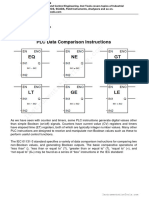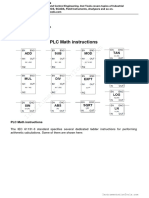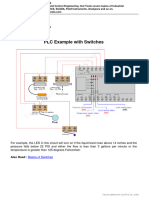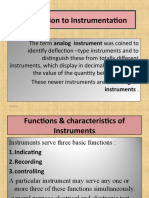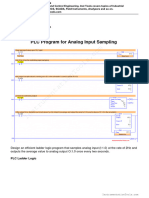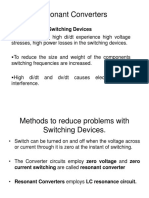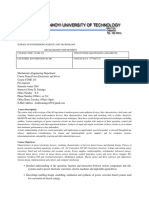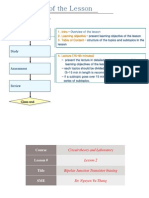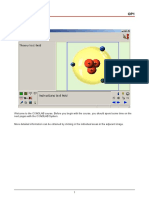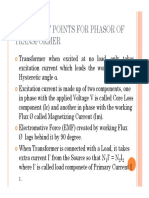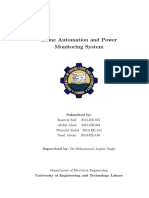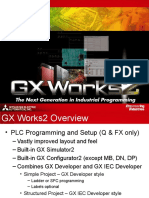0 ratings0% found this document useful (0 votes)
524 views67 pagesGX Works 2 Advanced PLC Tutorials - 2
The document outlines a training course for sequence programmers using MELSOFT GX Works2, focusing on improving productivity, quality, project management, and security measures in the development environment. It includes a structured curriculum covering programming, debugging, and project management, with practical applications and functions provided by the software. The course emphasizes the importance of efficient programming practices and security protocols to enhance the overall development process.
Uploaded by
mahesh.durgaleCopyright
© © All Rights Reserved
We take content rights seriously. If you suspect this is your content, claim it here.
Available Formats
Download as PDF or read online on Scribd
0 ratings0% found this document useful (0 votes)
524 views67 pagesGX Works 2 Advanced PLC Tutorials - 2
The document outlines a training course for sequence programmers using MELSOFT GX Works2, focusing on improving productivity, quality, project management, and security measures in the development environment. It includes a structured curriculum covering programming, debugging, and project management, with practical applications and functions provided by the software. The course emphasizes the importance of efficient programming practices and security protocols to enhance the overall development process.
Uploaded by
mahesh.durgaleCopyright
© © All Rights Reserved
We take content rights seriously. If you suspect this is your content, claim it here.
Available Formats
Download as PDF or read online on Scribd
You are on page 1/ 67
Wl PLC_@X_Works?_Advanced|_ENG
9 MITSUBISHI
ELECTRIC
Changes for the Betier
PLC
GX Works2 Advanced
This course provides knowledge of the functions
to improve the development environment of the
design site having problems about "productivity,"
“quality,” "project management," and "security
measures." The course is intended for sequence
programmers who already use MELSOFT GX
Works2.
Copyright ©2014 Mitsubishi Electnc Corporation All Rights Reserved
LNANONTISENG
Wl PLC_GX_Works?_Advanced_ENG
Cann Purpose of the Course b}
This course provides knowledge of the functions to improve the development environment of the design site
having problems about “productivity,” “quality,” "projact management,” and "security measures.” The course
is intended for sequence programmers who already use MELSOFT GX Works2.
Wl PLC_GX_Works?_Advanced_ENG
[_introduction| Course Structure )
‘The contents of this course are as follows.
We recommend that you start from Chapter 1.
Chapter 4 - Improving Development Environment Using GX Works2
You will learn the problems facing the design site and the development environment required for solving
them
Chapter 2 - Programming
You will learn the functions used for programming,
Chapter 3 - Debugging
You will learn the functions used for debugging
Chapter 4 - Project Management and Security Measures
You will learn the functions for project management and security measures at the stage of development
and maintenance afier the start of system operation,
Final Test
Passing grade: 60% and higher
Wl PLC_GX_Works?_Advanced_ENG
[_introduction| How to Use This e-Learning Tool b}
Ce uot) Go to the next page,
eee ea) Back to the previous page
“Table of Contents" will be displayed, enabling you to navigate to
the desired page
Exit the learning,
Window such as “Contents” screen and the learning will be closed.
eternity
Cr)
WW 2-CX_Works?_Advenced_n200115_eng-A
Cz Cautions for Use )
Safety precautions
‘When you learn by using actual products, please carefully read the safety precautions in the corresponding manuals.
Precautions in this course
- The displayed screens of the software version that you use may differ from those in this course.
Wl PLC_GX_Works?_Advanced_ENG
{ Chapter 4| Improving Development Environment Using GX Works2 )
Learning steps in Chapter 1
‘This course is intended for programmers working on the development of sequence programs. You will lean how to use the
excellent functions in MELSOFT GX Works? to solve design site problems related to productivity,” “quality,” “project
management,” and “security.
In Chapter 1, you will learn about the problems facing the design site and the development environment required for solving
these problems,
4.1 Problems Faced by the Design Site
4.4.1 Improving Productivity
1.1.2 Improving Quality
1.1.3 Project Management
1.1.4 Security Measures
4.2. Learning Procedure
Wl PLC_GX_Works?_Advanced_ENG
Problems Faced by the De:
While the design site is required to improve productivity to reduce development costs, it must also ensure thal the
developed programs are of high quality
The design site must also conduct project management that allows team development and ensures quick recovery in the
case of trouble.
Security measures are also required because sequence programs include important knowledge and data.
WW 2-CX_Works?_Advenced_n200115_eng-A
El Improving Productivity )
The design site is required to develop sequence programs to handle large-scale, complex processing.
However, the cost of development increases in line with the length of the development period
Thus, you are asked to improve the productivity of program development in order to reduce the development cost.
GX Works? provides the following functions to solve this problem:
Label
Function block
Device initial value and device memory”
Inline structured text
Import from sample comment
* The MELSEC-F series cannot configure device
initial values.
WW 2-CX_Works?_Advenced_n200115_eng-A (elec
ooo
Ea Improving Qu )
‘A bug in the sequence program could cause a system stop, fault, or accident, which would halt production and
result in the loss of profit and reliability,
You are asked to develop quality programs that are free of any bugs.
‘GX Works? provides the following functions to solve this problem:
+ Label
+ Function block
+ Device initial value and device memory”
+ Comment
+ Import from sample comment
+ Watch
+ Cross reference
+ Sampling trace*
+ Executional conditioned device test”
+ Step execution function
+ YO system setting
“The MELSEC-F series cannot use device initial value settings, sampling trace, executional conditioned device testing,
and the step execution function.
Wl PLC_GX_Works?_Advanced_ENG eh
ooo
ali Project Management )
A large-scale sequence program is often developed by a team of programmers,
From the viewpoint of individual management authority and data confidentially, mits must be established for the range of
accessible data and usable functions.
In addition, to ensure quick recovery in the case of program loss due to programmable controller failure, you are asked to
implement program version management and periodic program backup.
GX Works? provides the following functions to solve these problems:
+ Security
+ Revision history
+ Verify with PC
Wl PLC_GX_Works?_Advanced_ENG
Security Measures
The sequence program includes strategically important knowledge and data.
The leakage of know-how and data from the program to the outside could have a devastating imoact on business.
Unauthorized modification of the program could lead to production problems such as by stopping the system.
The appropriate security measures must be taken to prevent these problems.
GX Works? provides the following function to solve these problems:
+ Security
WW PLC_GX_Works2_Advanced_ENG
em Learning Procedure )
In this course, you will leam about the GX Works? functions by following the procedure for actual system,
development.
(1) Programming .. Chapter 2
(2) Debugging... Chapter 3
ee
(3) Project management and security measures .. Chapter 4
‘
The icons displayed on the pages in Chapters 2, 3 and 4 correspond to the respective improvement functions, as
shown bolow.
© Function used for improving program quality
& Function used for security measures
Wl PLC_GX_Works?_Advanced_ENG
GZ Programming )
Learning steps in Chapter 2
In Chapter 2, you will leam about the functions used for programming,
GX Works2 provides many different functions to ensure efficient programming and improve the quality of programs.
2.1. Replacing the Device Name with a Name Associated with the Application,
2.4.1 Label Types
2.1.2 Types of Label Applications and Stored Values
2.1.3. Label Registration
2.1.4 Automatic Assignment of Labels to Devices
2.2. Arranging Repeatedly Used Ladder Blocks as Function Blocks for Diversion
2.2.1 Creating and Placing Function Blocks
2.2.2 Using the Function Block Library
23 Changing Device Initial Values without Correcting the Program
2.4 Simpltying Ladder Programs
25 Creating Programs that are Easy to Understand and Read
2.5.1 Writing a Comment for Each Ladder Block
2.5.2 Writing a Comment for Each Output (Coil, Application Instruction)
2.6 Making it Easy to Read Programs Containing Special Relays/Registers
WW PLC_GX_Works2_Advanced_ENG
Introduction of System Used for Learning in this Course
This course employs the following hypothetical system to help you leam how to use the GX Works2 functions:
Process B {Completed |
product sensor
Process B defective
Process A
{component placement)
Parts mount
Neral
seston _) ‘
0 Aa
i =
Scr ttetwepntonsasae ( Back to Top.)
WW PLC_GX_Works2_Advanced_ENG ela
ooo
yaa Replacing the Device Name with a Name Associated with the Application (Frciuctwis) Ee
A device used in the sequence program is given a name that consists of a letter followed by a number, for example "MO" or
"DS.
Thus, the device name does not provide any clues as to the application of the device,
A large-scale program uses many different types of devices, which means that during programming, you must continually
check the system design documents to determine the application of devices. This reduces the work efficiency and adversely
affects the program quality due to errors in selecting devices.
“Labels” can be used to solve these problems.
Instead of using a device name, you can use a name (label) that indicates the actual application, for example “Production
line start signal.”
For this type of name, Japanese (hiragana, katakana, and kanji) characters can be used in adcition to alphanumeric
characters,
—{ SET Mo }—
—1 SET Production line start signal }—
Using this type of label is effective for creating an easy-to-read program, improving the efficiency of program development,
and preventing device input errors,
Lp ump ieee
WW PLC_GX_Works2_Advanced_ENG
Label Types
There are two types of labels: “global label” and “local label.”
Global labels are used for an entire project and can be accessed by any program in that project.
Local labels are used in a specific program and can only be accessed by the program in which the label is registered,
‘Program 1° and “Program 2" are
‘outtons.
Press either program to see iritcan
‘2ncess the two types of abel.
W@ 1-GX_Works?_Advenced_na00125_s
Types of Label Applica
When registering a label, specify the label application and the type of value that can be stored by using “Class” and
“Data type.”
The class indicates the use range and application of a label.
The classes that can be selected vary depending on the type of label.
Se rod
‘Common label that con be used by programs and function blocks in
ect Coro
SZCMCTe MMI Common label with a constant that can be used by programs and
rors function blocks in a project
‘Label that can be used by programs and function blocks for which
Mas the label is intended
‘Label with 2 constant that can be used by programs and function
Mee ceidlaallll blocks for which the label is intended
‘Label with 2 constant that can be used by programs and function
MOS ALSIIN blocks for which the label is intended
{Label used for the input oF @ function block for which the label is
See Intended
* The value cannot be changed in a program component.
Reta 202) used forthe output ofa function block for which the label
Label used for the input and autput of a function block for whieh the
DCM MCT labels intended
* The value can be changed in a program component.
°
WW PLC_GX_Works2_Advanced_ENG
abr Types of Label Applications and Stored V:
The data type refers to the type of value stored in the label.
The data type assigned to a labol indicates the type and range of values that can be stored in the label and the
corresponding device.
‘The data types that can be used with ladder programs are listed below.
are Description Bitlength | Range of values stored
‘ON oF OFF i stored ,
_ Gorrespontis to device “Mr EAE | RGAE:
Rector} ‘An integer without fractions s stored ve bits | “32768 t0 32767
Peer tere IN| Corosponds to coves “D" ‘S2bits | 2147409080 10 2147400047
‘Aroal numbor including fractions is stores, roots [210-20 202"
Corresponds to device "D S2ots _| 20-270 0, Damo ZIRE
‘Acharacior sting i stored
Corresponds to device "D*
Varite | Up 0 255 characters
Turns ON when the specified ime is reached.
Gorresponds to timer device "T™
a Tums ON when the spoced time is reached. 7 -
Corresponds o retentive timer device "ST"
Turns ON vinen the specified count is roached.
— Corresponds to counter device °C”
| ‘A subroutine slat position is stored
~ Corresponds to pointer device “P* > >
Wl PLC_GX_Works?_Advanced_ENG
ax
Project
ah Se Ah
gree
Seceeinrn
3 Senter ene
=e aoa!
ca
agg Pewonsethn
= Beem
3 roan
ana.
qwruee
ards
aed tnves care
are
Some mnelvae
| User Library
Connection Destination
st Eden Compile Yen
ae
2 aR,
rire Cetug
ess
egress Teel Whom Hep
2,36 0S ot | 22 | | ty
Be Se Vidhy ieee AA Dec sy
‘Pra Wk= NAT (Is4tp™ | Cy ibe Label Sting aba
LkelNone Date Tipe
Fraction catered
Fate_weut ot toa
Stal iene oleae
Finish ihe settings for lel registration,
Ciek (BED to proceed
Gall Label registration )
WW 2-CX_Works?_Advenced_n200115_eng-A
2 Automatic Assignment of Labels to Devices Qe
Converting a program automatically assigns the appropriate device to the label according to the class and data type.
When using a label, it is not necessary to know which device is assigned,
Use “Device/Label Automatie-Assign Setting” to change the range of devices assigned to the label.
* This screen is the automatic assignment device setting window for the MELSEC-Q and MELSEC-L series. The screen
may differ for the MELSEC-F series
From the GX Works2 menu, select [Tool] ~
Sa avin emima NC [Device/Label Automatic-Assign Setting]
ee tobot control - [[PRG]Write MAIN 194 Step]
eee
aaa SUEEEEEEE EEEEEEEEE Teal | window He
aor oa Ltt rican
4 = TC Memary Card vie
pie
ersten GD
| ‘Check Parameter.
Options...
Key Customize,
Block Password... b
Confirm Memory Sie
Set TEL Data/Connect via Modem >
= Set ST
Learnt anon eres son nde ute ewe ot ene Siiiet Adatevenee Gotgabattons: | F
2 Gusisieetpret cet tas os See omen caadnnatmacpnetonnt eh ta Buln YO Module Tool »
Cem) Check Inteligent Function Module Parameter >
Inkeligent Function Module Teo >
{| Lenauase Selection L
Wl PLC_@X_Works?_Advanced_ENG
yard
\ging Repeatedly Used Ladder Blocks as Function Blocks
Diversion
Ina large-scale program, some laddor blocks may be used repeatedly.
Or, some of the same ladder blocks may be used in different programs.
Work efficiency cannot be improved if you must input the same ladder block every time it is needed,
In addition, if a defect is found in a comman ladder block, each biock must be located and corrected. This causes a
significant loss of time.
Use “Function Block (FB)" to solve these problems.
A ladder block that is used repeatedly can be arranged as a function bleck, which can be used in every program. This
greatly improves the work efficiency,
If'a defect is found in a common block, all you need to do is correct the function block,
This not only saves time, but also prevents the risk of not correcting one of the blacks.
| Press ihe button towateh he
‘animation fom he beginning
MW PLC_GX_Works2_Advanced_ENG
nv
a Creating and Placing Function Blocks
Since the function block will be used in different programs, real devices (such as X, Y,
block. These devices must be replaced by labels as you learned in Section 2.1.
The procedure for arranging laddor blocks into a function block is shown by animation.
1. Prepare sprograrnt he arrangedints
funtion sas
2, Die the pgramitenpat an att
ica ru sevoe yn be
‘rae ani tbe
43, Flavetne erases tunston block inthe
rogrsmusing eau ans sos,
4, Aestan paaTetorst0 tho mut and
‘wip ae ofthe function blocsthat
you placed inthe program
and D) cannot be used in the function
Press the bution to
ret tothe tt Flow
Wl PLC_GX_Works?_Advanced_ENG
st GidiReplre Compile Yen Grine Oebug Digrosis Teel Whom Hep
LE PLe 2536 Bn 2 S| aL
Se eR AN A a TR A ST A cb ON SS
evigaton ax 7 Encino 4 >
Project
Chas Sa Ate
3 Peormer vod cows
& seer a
{3 cinarevesccmet
26 aaa
osu
2 Peon stra
= Btorm
SD Fon
Fen
2 reso
2 en a0
‘3 foomn
ene
(eased ie
isn eeatng me Tuncton Dok
{dy czmectionestnston tek CBE) to proceed
W@ 1-6X_Works?_Advenced_pa00115_eng-A
EA Using the Fun
in Block Library
You have now learned how to create a function block,
Mitsubishi Electric has arranged the control programs of various modules such as CPUs, analog input/output modules,
networks, and positioning modules as function blocks, which are available free of charge as the “FB Library.”
Using the FB library eliminates the need to develop module control programs, which was traditionally the users’ responsibility.
Even modules that you are not familiar with can be easily introduced.
The F8 library can be downloaded from the “MELSOFT Library Download” page on the MITSUBISHI ELECTRIC FA Website.
* Click the following URL to access the download page.*
bttp://wunvt2 mitsubishielectric.co jp/melfansweb/plceng/download/library/index_e.htm
* There is no FE library provided for the MELSEC-F series.
‘The supported models are listed on the download page. Please check the supported model before downloading.
MW PLC_GX_Works2_Advanced_ENG ela
ooo
1 Values without Correcting the Program (:0.:¥)
‘The initial value or constant of a device is normally set using the MOY instruction before the main program processing.
In this case, the program must be directly corrected each time the program operation is changed according to the system
application.
Not only is this method time-consuming, but there is also the risk of correction errors or failure to make a correction.
2.3 Changing Device It
Use “Device Initial Value" to solve these problems.
Using the GX Works? function ensures proper management of device initial values and eliminates the need to make program
corrections, thus allowing you to create programs much more efficiently.
In addition, this function eiiminates the need for an initial device value setting program, which would reduce the program
volume (memory usage) and decrease the risk of failure.
For the device intial value, specify the range of devices for setting the initial values.
Actual initial values are stored in the device memory and are assigned to the device range specified.
With device memory areas prepared according to the system applications, the device initial values can be changed by simply
changing the device memory area to be assigned.
Wl PLC_GX_Works?_Advanced_ENG
Poet Eat
DB FL.
| 215
=
=O rere
oan
ia aa
Qos
wre
Esai
Bostoscral
2 meemnay
ih
ee
cil ce nae
sean
Finish seitng ihe devies infial values and device
memory.
Giiek (BE to proceed
WW PLC_GX_Works2_Advanced_ENG
a Simplifying Ladder Programs
Ina large-scale ladder program, the connection of devices, instructions, and ruled lines can become quite complicated, making
it difficult to grasp what processing the program performs.
In particular, numerical calculations, such as a formula completed on a single line, must be programmed using a combination of,
instructions.
Use “Inline Structured Text” to solve these problems.
A ladder program is replaced by a program that is partially written in structure text (ST) language.
‘The ST language is a sequence control programming language similar to C language used for computer software programming.
‘Numerical calculations can be written using formulas, so even programmers who are not familiar with C can use inline
structured text,
‘The following figure shows an example in which part of the ladder program for the system is replaced with inline structured text.
‘You can see that the complicated latter program is now easy to understand.
Press the button to watch the
anion from the beainnins
MW PLC_GX_Works2_Advanced_ENG eae
Teal hilo Hep
Prebedric
eles ren
Sgyrarnerrodreow ie ee
tee Pees Feta nr eet nea pedo
Gina toves coment
=i ante ‘i
eb cba cst Dl
enon ary
rare
‘alee
a
Bicttea
war
Sched ae
cree Cara
= tone reery
2 once ae
Finis sein he mine srucured text
ick (> to proceed
Sams wi ——)
Wl PLC_GX_Works?_Advanced_ENG
ca Creating Programs that are Easy to Understand and Read
‘You may find it difficult to understand the details of control in a large-scale program by just looking at the program. The
following problems can occur as a result:
+ You make program errors (such as input of incorrect instructions or devices).
+ You are unable to find the causes of program errors.
+ Someane taking over the programming cannot understand the details of control
Use “Comment” to solve these problems,
‘Momos such as control information and device names can be attached to the program so that the dotails of control can be
easily understood,
‘These comments should be input wherever possible to create programs that are easy to understand not only for you, but
also for others.
Hii ——+ Hi}
|
‘GX Works? allows the following comments to be input.
‘Comment
‘A comment can be attached toa dove.
This comment indicates the application of each device and the ype of connected UO device
‘A comment can bo attached to a ladder block
‘This comment makes the low of processing easy to understand
— ‘A comment can be allached 1o a col/appicaton instruction inthe program,
This comment makes the contents ofa col (output) and an application instruction easy to undorstane.
[@ PLC_GX_Works?_Advanced_ENG | ica
£m Writing a comment for each ladder block )
Gaitiartone
E Boke Gat EhdiReplce Commie Yon Orie Cebu Degrosis Teel Whom Hep
‘2 Fo. 2. 5 ne 2 || oA
Ye) Fh) BR | BN A SB See AP ee ol I US SIE UR i he bw | | 5
Navigation ax
a>
(a 3.2) Ate.
5 B5 Paraeter res wo conol 2
Irtllgetruncen Made
obat ence conrant
= AG) Gebal ete!
2 oman setra
= Garo
Progam
=a) Hen
1) Proven
GB loa iba
ro
Seiad Osta Trees
(Buccal bevee carrent
(@) dence eners
2 4 See al Vale
Finish setting the ine statement,
Click (5) to proceed
Wl PLC_@X_Works?_Advanced_ENG
Poked Eat
EhdiReplce Commie Yen Grire Deiuy Degrslics Tl Mrdon tp
| Rl SS |
apts 43 |e Le Be ts ae Ie ak
ro We contol =
Inte runcen Made
‘ool cee canner
= AG) Gebal eb
2G Poon set
Brot
= ree
an
gone
Sica
ane
Src ices
BB raeue comet
Derce Pay
towel ke
Finn seg te note
Ciek CB) to proceed
MW PLC_GX_Works2_Advanced_ENG
Making it Easy to Read Prog)
If special relays, special registers, and/or intelligent function module devices are used in a program, it can be difficult to
undorstand all of the applications and functions of these devices. You need to read the program with the manual in your hand.
Although the program would be easier to read if a comment is attached to each device, considerable time and offort would be
required for attaching comments if many devices are used.
Use “Sample Comment” to solve these problems.
GX Works2 provides sample comments describing the applications and functions of special relays, spectal registers, and
intelligent function module devices.
Using these sample comments makes it much easier to attach comments to devices to make the program easy to read.
The sample comments can be modified as necessary.
Wl PLC_GX_Works?_Advanced_ENG
Boeck Et Reece Commle Yen ire Deluy Degroslics Tel Mon tp
ASS
Scene
aoc
ag anate
29 povensetry
Bt
pen
‘oven
Shas
20s,
ant
Frtodode ies
ee
2 enererey
Finish the automate seting ofa sample comment
ek (35> to proceed.
Wl PLC_GX_Works?_Advanced_ENG
‘GEE Debugging )
Learning steps in Chapter 3
In Chapter 3, you will lea about the functions used for debugging.
GX Works2 provides many different monitoring and debugging tools to correct errors (bugs).
Creale error-free, quality programs using these monitoring and debugging tools,
3.1. Monitoring Only Target Devices and Labels
3.2 Checking Use Status of Devices and Labels
3.3. Collecting Information an Device Value Change over Time
3.4 Changing Device Values without Correcting the Program
3.5 Debugging Program Operation Step by Step
3.5.1 Using the Step Execution Function
3.6 Simulating the Operation of an External Device
3.6.1 Inputting Device Values for Setting the VO System.
3.6.2 Using the Timing Chart Format for Setting the iO System
MW PLC_GX_Works2_Advanced_ENG
Monitoring Only Target Devices and Labels
‘A program uses many instructions and devices.
In addition, the long vertical length of a program means that only part of itis dix
screen,
Therefore, the ladder monitor alone cannot monitor the entire operation.
layed at a time on the PC monitor
Use “Watch” to solve these problems.
This function can be used fo monitor only the devices and labels that you have specified in advance.
Two or more Watches can be created to ensure that each range is monitored.
Wl PLC_GX_Works?_Advanced_ENG
eal Monitoring Only Target Devices and Labels )
TR Ghdfenlxe Comale Yon rire Orluo Deorsts Tiel iro top ~ ax
OB Pe. B65 oe) P| a 2 i Bw 8
BRB | A ee a 2 dB IS | ee OL
‘tlh ST oh 3 SG co 25 tm 1 8 96 Oo
aviation x x aoe
So.) Ate =
3D Paneer ode
tneaat uncon Yad e
4} dibal Device Crue ~
2 Goalie
By roensctng swt
ey pe © aN
= Rowan
0 ae as
— im
Le
"The present values of the devices registered with Watch 1 are monitored. —
Device Lobe CunelAfdue | Date Type Class | Device Comment
0 a a ° Sie ch
x a ae Fars ro ent
Ra a a 2
fe i 7 fe Fnisn iatcnregistation and montonng
|Ciick (35> to proceed.
\Bwoteh | Bwaiehe
Bah Sra wane Smston en
awn
MW PLC_GX_Works2_Advanced_ENG
ooo
Checking Use Status of Devices and Labels
‘A program uses the same devices and labels at different locations.
‘You may want to check the use status of these devices and labels by comparing them between locations.
Use “Gross reference” to do this.
This function lists the locations of the devices and labels matching the search conditions so that you can compare them and
check for incorrect usage.
Wl PLC_GX_Works?_Advanced_ENG
eal Checking Use Status of Devices and Labels )
FF MELSOFT Sories GX Works2 C:\Soquential Programs\o.loarnine\Robot control [[PRG]Write MAIN 194 Step]
Brio Edt EindRerloce Conple Mew Sine Dokia Ceareacs Tol Wirdon Hep
SP Pile. 7 GE he | RBH | AA RD | | te heh | A a
(soe) BAT | th Ae SE EE 62 AE ro abe gh a ee ts he ib) GTN 5 Sk
navigation ax
cas
rr
Soctrerrar
Boome
ep settee
erase
fou
2 rosen
Pain
(ass Referee fama | Condton Seta]
Devee(tazel [Or 5 Pent reve
[Deviziabel [Devs neuron [LadlerSyrbel_Poston
a — Prnishwang Gross Reterence
i i o
Bo mt a Serle
[Ey 8 dovestacesrferoncs iniernaton of bo"
Eh Sipe Fost staten
avo —
WW 2-CX_Works?_Advenced_n200115_eng-A (elec
Collecting Information on Device Value Change over Time
‘You may want to confirm that the changes in device and label values are within the design range or perform
troubleshooting by checking the changes that have occurred in the event of a failure.
Use “Sampling Trace” in this case. (Only for MELSEC-Q and MELSEC-L series)
This function can be used to monitor and record the changes in device and label values over time, The record can
be saved to files.
Wl PLC_GX_Works?_Advanced_ENG
eal Collecting Information on Device Value Change over Time )
at ee ee
E Boket Eat EidiReplre Comle Yen Grine Cebu Dgrostis Teel Whom Hep
DE BLe,
Peed ae ER I at 2 RETIN) Colton M373 a tay
dice GE ES Ls sie Ae
c 502) Bt
3 esrarete Proc i= cont
InelgsneFuncen Vd
hha Seve Cone
211) cealitot
ff Posten Setng
a
Pats rout a
Statvaectpe Bt
rauczen Bt
Fratuson. WoSined)
Foeo2sA de Wd nee
Process de Wo cned)
Bin Statewtch et
v0 PatsFpie se
ea) man Free A deoa! Bt
19 Frozen Frc B deel
Local
Give!
seucaned ota Tyne
eel Deve Cannan —
4 Derce rerery ¥
Fraucton. Wor aned)
Focessa de Word ned]
Press de Wo cned)
Fins seting the sampiing race.
[click C5) to proceed.
Shuster
Peery
W@ 1-6X_Works?_Advenced_pa00115_eng-A
Changing Device Values without Correcting the Program
When performing debugging, you may want to forcibly change device values to check the difference in program
operation.
However, this means that you must modify the program each time a device value is changed, which takes considerable
time and effort.
In addition, if you forget to set the modified program back to the original settings, it may cause another failure.
Use “Executional Conditioned Device Test” in this case. (Only for MELSEC-Q and MELSEC-L series)
This function changes the device values upon execution of the step number specified in advance, without your having to
modify the program.
Wl PLC_GX_Works?_Advanced_ENG
Bi
BSE RS ote ho SH SAS SIE EN BS ta as iw fo 28)
hha Seve Cone
(8 cebalakot
2 Posten Setng
2 trou
= QFvom
Ea me
9 Prose
2 (Q) Paravete Prod went |
InelgsneFunsen Vods
€
ra Finish the Execusional Gondiioned Device Test.
ay |ctiek (BE) to proceed,
ERR,
UseR
Shuster
WW 2-CX_Works?_Advenced_n200115_eng-A
Debugging Program Operation Step by Step
During debugging, you may want to confirm the instruction execution in each step or check for changes in a device value,
However, step-by-step debugging can be difficult due to the fast program execution speed (scan time).
Use the “Step Execution Function” to solve this problem. (Only for MELSEC-Q and MELSEC-L series)
This function enables program execution one step at a time and thus implements step-by-step debugging.
Use the step execution function together with the simulation function. (The step execution function cannot be used for
debugging on an actual PLC)
The following functions can be used by the step execution function.
Function Description
This function executes the program unt the speciied break conditions are satisfied
Break | Progra execution is siopped when the break condtons are satisfied,
roa
Uso steak paar eat don spat he br conden
ee
et
exoeaton | TRS function executes the program ony from the specitied location
WW 2-CX_Works?_Advenced_n200115_eng-A
MELSEC-L series)
changes to locate a fault.
Set a break point where you want to
interrupt program execution.
Specify this in units of steps.
Up to 64 break points can be set in the
entre project.
Skip range application>
Using the Step Execution Fun:
Set a break device based on which program
‘execution is interrupted when the device or
label value satisfies the specified condition,
Up to 16 bit and/or word devices can be set
Afailure point can be narrowed down by using the skip range.
Perform break execution with and without a skip range set
Ifa failure occurs only when the skip range setting s released, ths indicates that the range includes a fault.
Specify a break point and break device as the debugging start location and start condition, respectively.
You can also specify a skip range within which you want to temporarily avoid program execution. (Only for MELSEC-Q and
When the break conditions are satisfied after break execution is started, program execution is interrupted
Thereafter, while executing program operation step by step with the step execution function, check for device value
Sot a range within which the program should
riot be executed, in units of ladder blocks,
during step execution,
Up ta 16 ranges can be specified in the entire
project.
Wl PLC_@X_Works?_Advanced_ENG
Irellges Funcion Mids
‘ooal ceve canner
2g Gest
Poaran sentra
Pou
Broon
= gnen
[Debugging Is completed. Finish te step execution
function
Click (E> to proceed.
Wl PLC_GX_Works?_Advanced_ENG er)
ooo
ig the Operation of an External Device
Debugging in conjunction with the operation of an extemal device is not possible in a development environment in which an
extemal device cannot be used, such as the simulation function,
To solve this problem, a debugging program that simulates the operation of an external device is conventionally added.
However, not only does it take considerable time and effort to create a simulation program, but itis also necessary to modify
the program when changing the operation
Use “lO System Setting” to solve this problem.
This function can simulate the operation of an extemal device without using a debugging program.
The operation of an external device can be easily sot or changed in the setting window. Therefore, conventional program
creationimodification is not necessary.
The operation of an external device can be set in the following two ways:
‘A device change that has been set in the specified timing chart format can be driven when the specified conditions are
satisfied
Wl PLC_@X_Works?_Advanced_ENG
Perarete: Pod incon
InelgsneFuncen Vos
bel Device Cone
aoa be!
Frown
Loc abel
aa
ro
cv)
Ea
ee
Finish he device vaiue setting and execision.
Giek (5 to proceed
Shuster
Bree 2) ae ee ie
(hha Seve Conrmet
(8 cealako!
2G Posten Seting
eae
=) Frog
Ean
9 Fron
Lac abel
Se)
2 PraneterPodine cant x
InelgsneFuncen Vods
Finish he timing chart setting and execution.
[Click CD to proceed.
Sruaton
MW PLC_GX_Works2_Advanced_ENG ela
ooo
Gaz) Project Management and Security Measures )
Learning steps in Chapter 4
In Chapter 4, you will leam about the functions used for project management and security measures.
4.1 Preventing Leakage of Know-How and Unauthorized Modification of Programs.
4.1.1. Limiting Accessible Data by Each User
4.2 Project Backup and Version Management
4.3 Comparing Programs Saved to Programmable Controller and Personal Computer
Wl PLC_GX_Works?_Advanced_ENG ol ea
ooo
aa Preventing Leakage of Know-How and Unauthorized Modification of Programs E> &®
‘The sequence program includes strategically important know-how and data.
The leakage of know-how and data from the program to the outside could have a devastating effect on business.
Unauthorized modification of the program could lead to production problems such as by stopping the system.
Use “Security” to solve these problems.
This function limits the users who can access each project under protection by password.
I-can also limit the range of data or functions that each user can access or operate.
The function thus prevents unauthorized users from browsing or editing programs.
WW PLC_GX_Works2_Advanced_ENG ela
ooo
lla ing accessible data by each user ae
A large-scale sequence program is often developed by two or more programmers sharing the work.
Ina case of team development, the range of accessible data and available functions must be properly managed according to
‘the work range and skills level of each programmer and the confidentiality of the data handled by each programmer.
This access management can be implemented by setting security access levels.
Operation privileges for the data included in the project can be set for each user.
‘The following five access levels can be set
High] Administrators ‘Administrator level | Authorized to use al functions,
Doovelopars (Lovels)
Secu Developerteve | S2eury sotings, data accessing and some
operations are restricted
Developers (Levelt)
‘Only project data browsing is avalable Unable
to read ftom PLC GPU.
Lew] Users Operator level
Wl PLC_GX_Works?_Advanced|_ENG
E Bobet Co CiaRece Connie Yon Orne Orla Dares Trl hon Hp
TN BO 2 | | | as
Sig treo ros sco)
B teat incanroe
$F dindcerer commer
2G) aeaice!
2 ip menan Seta
Sr
9) Frog
Lc Label
rho!
Seated Osta Trees
Local Deve Cnet
Device Hrery
ce ill
Finish the Security Setting.
cick CE) to proceed
Wl PLC_GX_Works?_Advanced_ENG er)
ooo
Call Project Backup and Version Management Ce)
An important program could be lost due to programmable controller CPU failure.
Ia backup program is not available, there is litle hope of a quick recovery.
Even if a backup program is available, it would be difficult to determine if the version is the same as the last program unless.
version management is secured.
To be prepared for unexpected circumstances, itis necessary to conduct periodic backup and ensure version management.
Use “Change history” to solve these problems.
This function can record up to 100 sets of change histories (history number, date/time, user, tlle, comment) of the project.
The project data at the time of recording is also backed up at the same time.
Version management ensured by the change history function allaws you to restore lost programs, verify program versions,
and thus implement quick recovery in the case of unexpected circumstances.
Wl PLC_GX_Works?_Advanced_ENG
pene 2 Bite Bde i a eae a fo) BS
ir
teat Fane Pde
§ dace cme
2G) deals!
semansetea
*O
= hrcaran
Sein
“3 Pra
toc ate
= rel
Sbutedta ses
altentecamnet
Deveney
eve a he
Finish the change nistory regstration, restore
process. and verineation
Ciek (BD to proceed
oad
MW PLC_GX_Works2_Advanced_ENG
‘Comparing Programs Saved to Programmable Controller and Personal Computer
Normally, programs are saved to a PC in the development environment and they are also written to the PLC.
These two programs are not always the same.
Performing only a visual check to see if they are the same could result in errors.
Use “Verify with PLC" to solve this problem.
This function can verify that the program opened by GX Works2 matches the program written to the PLC.
Wl PLC_GX_Works?_Advanced_ENG
Gal ‘Comparing Programs Saved to Programmable Controller and Personal Computer )
FFE MELSOFT Series GX Works? C:\Sequential Programs\e-Learning\Robot control -[[PRG]Write MAIN 194 Step]
Boiect Est EdRenece Cmale Yen rire Oekuy Degrslics Tl lon Hep
DB FLe. 2 36 S50 ok pl) A | to AL Ve
EE HSE AE 42 Fe ate 2S ohn SEF 3H TE 8 BS Sh as os in fs S| 2S
tage Pucen oe
Gina boves coment
2 Salibe!
2g pean setra
5 Brot
Brose
ere
ia aoa
toes
ann
Soro ices
ialbewe cast
2) done revo
2B rental te
Finish the onine program venicaion
|Ciek (3 to proceed
MW PLC_GX_Works2_Advanced_ENG
er)
zm Final Test )
Now that you have completed all of the lessons of the PLC GX Works? Advanced Course, you are
ready to take the final test. If you are unclear on any of the topics covered, please take this opportunity
to review those topics.
‘There are a total of 8 questions (8 items) in this Final Test.
You can take the final test as many times as you like.
How to score the tost
After selecting the answer, make sure to click the Answer button. Your answer will be lost if you
proceed without clicking the Answer button. (Regarded as unanswered question.)
Score results
The number of correct answers, the number of questions, the percentage of correct answers, and the
pass/fail result will appear on the score page.
Comectanswers: 2
To pass the test, you have to
Ree: = § answer 60% of the questions
correct,
Percentage 2%
Procoed_] [Review] [_Retiy
+ Click the Proceed button to exit the test
+ Click the Reviow button to review the test. (Correct answer check)
* Click the Retry button to ratake the test again.
Wl PLC_GX_Works?_Advanced_ENG
Label
Inline structured text
© Funetion block
‘Answer
Back
Wl PLC_GX_Works?_Advanced_ENG
‘Answer
Back
Wl PLC_GX_Works?_Advanced_ENG
Device comment
Line statement
Note
‘Answer Back
Wl PLC_GX_Works?_Advanced_ENG
ێ Test | jal Test 4 )
© Compares the pragram being edited with a program recorded in the change history.
Compares the program being edited with a selected program saved to the PC.
© Compares the program being edited with a program written to the PLC CPU.
‘Answer Back
Wl PLC_GX_Works?_Advanced_ENG
ێ Test | jal Test 5 )
‘Simulates the operation of external I/O equipment an the personal computer during debugging,
Remotely controls the operation of extemal I/O equipment from the personal computer during debugging.
© Simulates the operation of the PLC CPU on the personal computer during debugging,
‘Answer Back
Wl PLC_GX_Works?_Advanced_ENG
erm al Test 6 )
‘Which oF the flowing isthe comect explanation forthe “Change histor’ function? (Choose one.)
Records the operation of GX Works? step by step so that it can be freely restored later
Records history information and backups of the project to enable verification and restoration ater.
‘Answer Back
Wl PLC_GX_Works?_Advanced_ENG
Break execution
VO system setting
© Executional conditioned devies test
‘Answer
Back
Wl PLC_GX_Works?_Advanced_ENG
Global label
© Local fabel of program A
Local label of program B
‘Answer
Back
Wl PLC_GX_Works?_Advanced_ENG
€ Ce Test Sci )
You have completed the Final Test. You results area as follows.
To end the Final Test, proceed to the next page.
Correct ansiners
Total 2
questions
Percentage big
= Te
You failed the test.
Wl PLC_GX_Works?_Advanced_ENG
‘You have completed the PLC GX Works? Advanced Course,
‘Thank you for taking this course.
We hope you enjoyed the lessons and the information you acquired in
this course will be useful in the future.
‘You can review the course as many times as you want.
You might also like
- MELSEC iQ-R Series Basics PLC Tutorials - 2No ratings yetMELSEC iQ-R Series Basics PLC Tutorials - 245 pages
- Electrical Machines for Engineering StudentsNo ratings yetElectrical Machines for Engineering Students19 pages
- Microsoft Word - INTRODUCTION TO PLC CONTROLLERSNo ratings yetMicrosoft Word - INTRODUCTION TO PLC CONTROLLERS115 pages
- Chapter 2 - Component Interconnection and Signal Conditioning - Part1100% (1)Chapter 2 - Component Interconnection and Signal Conditioning - Part127 pages
- International Electrotechnical CommissionNo ratings yetInternational Electrotechnical Commission49 pages
- Lect1 Industrial Inst by SK Singh Google BukNo ratings yetLect1 Industrial Inst by SK Singh Google Buk12 pages
- Unit 3: Ideal Voltage and Current SourcesNo ratings yetUnit 3: Ideal Voltage and Current Sources1 page
- Engineering Prob & Stat Lecture Notes 6No ratings yetEngineering Prob & Stat Lecture Notes 612 pages
- Wheelchair Stabilizing by Controlling The Speed Control of Its DC MotorNo ratings yetWheelchair Stabilizing by Controlling The Speed Control of Its DC Motor5 pages
- NPTEL Phase II - Electrical Engineering - Embedded SystemsNo ratings yetNPTEL Phase II - Electrical Engineering - Embedded Systems4 pages
- MEMO - FIC1502 - 2021 - Assignment 01 Final PDFNo ratings yetMEMO - FIC1502 - 2021 - Assignment 01 Final PDF13 pages
- Home Automation and Power Monitoring SystemNo ratings yetHome Automation and Power Monitoring System55 pages
- Lab 1 - Open Loop Temp Control - SignedNo ratings yetLab 1 - Open Loop Temp Control - Signed10 pages

